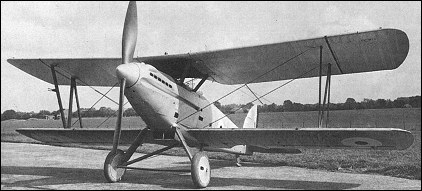|
| A fabric-covered all-metal single-seat shipboard fighter
designed by Harold Bolas to Specification 21/26, the
Pipit equi-span single-bay staggered biplane was
powered by a 495hp Rolls-Royce F.XI 12-cylinder
water-cooled engine and could be fitted with either
wheels or floats. The first of two prototypes was flown
in 1928, but crashed when a tailplane spar failed as a result
of flutter. The second prototype, with a 520hp
F.XIIS engine and many other changes, was also lost as
a result of violent flutter which fractured the sternpost
whereupon the vertical tail surfaces were carried
away. Further development of the Pipit was then abandoned.
 | A three-view drawing (800 x 589) |
| WEIGHTS |
| Take-off weight | 1805 kg | 3979 lb |
| DIMENSIONS |
| Wingspan | 10.67 m | 35 ft 0 in |
| Length | 7.92 m | 26 ft 0 in |
| Height | 3.18 m | 10 ft 5 in |
| PERFORMANCE |
| Max. speed | 278 km/h | 173 mph |
| GrahamClayton, e-mail, 05.05.2024 04:54 The pilot of the first prototype, Squadron-Leader Jack Noakes, broke his neck but was able to resume flying. Needless to say, I don't think he flew the Pipit again. reply |
|
Do you have any comments?
|
| 
COMPANY
PROFILE
All the World's Rotorcraft
|








e
reply